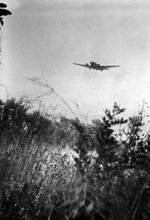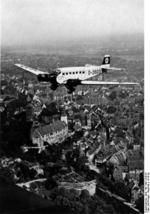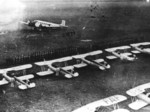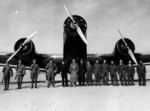Ju 52
| Country | Germany |
| Manufacturer | Junkers |
| Primary Role | Transport |
| Maiden Flight | 3 September 1930 |
Contributor: C. Peter Chen
ww2dbaseThe Ju 52 aircraft were designed by Ernst Zindel at the Junkers works at Dessau, Germany, starting in 1928. The design was based upon the previous W33 aircraft, also manufactured by Junkers, with the exterior constructed of strong corrugated Duralumin skin. The first prototype took flight in Sep 1930, with test pilot Wilhelm Zimmermann at the helm. In Nov 1930, the prototype was presented to the German military, and then the general public in Feb 1931. The second prototype was converted to a floatplane in Jul 1931 and tested by Zimmermann on River Elbe. Production officially began in 1932, but sales figures were low; only one of the first seven produced was sold. The only one sold went to the Canadian Airways; nicknamed "Flying Boxcar", the Ju 52 aircraft was used to supply remote mining operations.
ww2dbaseUp until the seventh example, the Ju 52 aircraft had only one engine. Beginning with the eighth, re-designated Ju 52/3m, the number of engines was increased to three. The first 3-engined Ju 52/3m aircraft took flight on 7 Mar 1932. Realizing the demand for cargo transports was not high, the Ju 52/3m aircraft were now being marketed as passenger aircraft; the shift in marketing strategy yielded great results. Orders from civilian airliners flooded in from Finland, Sweden, Romania, and of course domestically in Germany. Many of these 17-seat passenger transports were sold to Lufthansa, which ran a Berlin-Rome route that took only eight hours. A total of 400 civilian passenger transports were sold in the 1930s.
ww2dbaseIn late 1934, the Nazi government in Germany sought to expand the newly-formed Luftwaffe, and made an order for 1,200 Ju 52/3m aircraft configured as medium bombers, thus born the Ju 52/3m g3e military variant. Ju 52/3m aircraft first served in combat starting in Jul 1936 in the Spanish Civil War; they served both as transports as well as bombers, participating in the bombing of Guernica. On 4 Nov 1936, the first Ju 52/3m was shot down by Russian fighters near Madrid, Spain. By Apr 1937, they were retired from combat service in Spain due to their slow speeds, though they remained in service as transports. When Francisco Franco's Nationalists won the Civil War, 14 remaining aircraft (out of a total of 20 sent to Spain) were given to the new government as gifts.
ww2dbaseOn 24 Aug 1937, the Lufthansa crew consisted of pilot Carl August Freiherr von Gablenz, flight captain Robert Untucht, and flight engineer Karl Kirchoff flew the Ju 52/3m D-ANOY aircraft "Rudolf von Thüna", fully-laden from Kabul, Afghanistan over the Hindukush and Pamir mountains into China. They flew over the 5,300-meter high Wakhan Pass at the flight altitude of 7,000 meters, becoming the first passenger aircraft crew to fly over the Pamir moutains.
ww2dbaseAlthough deemed too slow, Ju 52/3m aircraft remained the standard transport aircraft of the Luftwaffe, with occasional duties as bombers. During the invasion of Poland, they bombed Warsaw. During the Norwegian campaign, several Ju 52/3m floatplane variants were deployed. In May 1941, Ju 52/3m aircraft served as paratrooper transports during the invasion of Crete, Greece. In 1943, they were used to supply the trapped German 6th Army at Stalingrad in Southern Russia. During WW2, they were nicknamed "Tante Ju" by German personnel.
ww2dbaseJu 52/3m aircraft were also used by minor Axis forces such as Hungary.
ww2dbaseJu 52 and Ju 52/3m aircraft were produced by Junkers until 1944. By that time, most were destroyed. After 1945, a small number were produced by French firm Amiot under the designation of AAC 1 Toucan and by Spanish firm Construcciones Aeronáuticas SA under the designation CASA 352. The last Ju 52/3m aircraft rolled off the production lines at CASA in 1952. A total of 4,835 were built between 1930 and 1952, most of which were made for military service.
ww2dbaseSource: Wikipedia.
Last Major Revision: Feb 2008
SPECIFICATIONS
Ju 52/3m g7e
| Machinery | Three BMW 132T radial engines rated at 715hp each |
| Armament | 1x13mm dorsal MG131 machine gun, 2x7.92mm MG15 machine guns, up to 455kg of bombs |
| Crew | 3 |
| Span | 29.25 m |
| Length | 18.90 m |
| Height | 4.50 m |
| Wing Area | 110.50 m² |
| Weight, Empty | 6,510 kg |
| Weight, Loaded | 9,200 kg |
| Weight, Maximum | 10,990 kg |
| Speed, Maximum | 265 km/h |
| Speed, Cruising | 211 km/h |
| Service Ceiling | 5,490 m |
| Range, Normal | 870 km |
Photographs
 |  |  |  |
Você gostou deste artigo ou achou este artigo útil? Se sim, considere nos apoiar no Patreon. Mesmo USD $1 por mês já vai longe! Obrigado. Por favor, ajude-nos a espalhar a palavra: Fique atualizado com WW2DB: |
Visitor Submitted Comments
20 Nov 2010 09:13:21 AM
Let's Explain in English:
Call her Tante Ju, (Aunte Ju) or Iron Annie
the Junkers Ju 52 was the Luftwaffe's work- horse. She was built tough met the demands in
Military and Civilian life.
She soldiered on long after she should have been replaced. Built of corrugated metal
skin, she wasn't a beauty but she was tough. Powered by three BMW air-cooled radial engines.
Lufthansa used her for airline service in Europe before WWII. In the 1930s you could
fly from Berlin to Rome in eight hours.
The backbone of the Luftwaffe's transport
squadrons served everywhere the German Army
fought. Whatever the job, flying cargo, mine
sweeper duties, Paratroop she did it well.
The Ju 52 was also used by Germany's Axis
Allies, and it was one of the few German
aircraft used by both Allied and Axis forces
during WWII.
The Ju 52 was slow and vulnerable to fighter
attack she was armed w/ one or two 7.92mm
machine guns. Some crews added a 20mm cannon, for more firepower. There was a seaplane variant that was used during the
Norwegian campaign of 1940.
About 5,000 Ju 52s were built and continued
serving in Post war Air Forces in Europe.
France built the Toucan/Ju 52 and saw service
in Indo-China.
Spain built the CASA 352 and retired them in
the late 1960s.
Other Air Forces continued to use the Ju 52
years after World War II.
"KEEP 'EM FLYING"
Today there are Seven Airworthy Ju 52s flying
used for Charter and Excursion flights in
Europe and the USA.
Surviving Junkers Ju 52s
Lufthansa has: one aircraft
Swiss Air Museum: has four aircraft
France: has one aircraft
Commemortive Air Force: has one aircraft
She served about everywhere, South America,
China, Canada, Finland and Sweden even the
Russians used th Ju 52 after WWII.
The USAAF used one Ju 52 and called her the C-79 for transport duties during WWII in the
Panama Canal Zone.
In 1958 she lost power to one engine the pilot tried to return to the airport, but crashed and was written off.
Did You Know...
The BMW Air-Cooled Radial Engine, that powered the Junkers Ju 52, was a refinement
of the American Pratt & Whitney Engine.
15 Jan 2011 10:07:49 AM
"WHAT'S THE OLD SAYING REPLACE A JU 52, WITH ANOTHER JU 52..."
The Junkers Ju 252 was to replace the Ju 52
transport development started in 1941, with
15 aircraft being built.
Like the Ju 52, the Ju 252 was also powered by three air-cooled radial engines the plane also had a rear loading ramp most of the aircraft was built of wood, all aircraft were supplied to the Luftwaffe.
THE SAME DESIGN, BUT NEW AND IMPROVED CALL HER THE GERMAN HERKULES:
Another design improving the Junkers Ju 252, was the Ju 352 keeping the basic design of
three air-cooled radial engines.
The cockpit was built of duralumin stressed-skin but aft of the filght-deck the fuselage was wood with steel tube frame with wooden formers and fabric skinning the loading ramp
was hydraulically-operated.
SPECIAL MISSIONS:
The Junkers Ju 352 were used by 1./KG 200 for special missions, dropping agents, and other special duties.
About 50 aircraft were built However, due to the worsening war siruation the program was cancelled. All aircraft served with the Luftwaffe.
By wars end the rest of the Ju 352 fleet was
destroyed by the Germans, to prevent capture by Allied forces.
Two aircraft survived World War II, one was flown to Britain, the other was found in Czechoslovakia the aircraft was refurbished
and used by the Czech Air Force.
In 1946 the Ju 352 was presented as a gift to
the Soviet Air Force and flown to Moscow.
1 Apr 2013 08:05:29 PM
THE HERKULES:
Junkers developed a replacement for its Ju 52 transport. The Herkules was powered by 3xair-cooled radial engines driving 3-bladed propellers of interest was the use of a Trapoklappe(rear loading ramp)don't you like those compound German words.
This was a hydraulically operated rear loading ramp, much like modern military and commercial aircraft use today. The new design used smooth skin and was constructed of non-strategic materials. 2-prototypes were built, 10-pre-production Ju 352A-O's and 33 production Ju 352A-1's were built before wars end. The Ju 325 was armed with 1x20mm cannon and 2x13mm machine guns in waist positions.
CLOAK & DAGGER:
The Ju 352 was used to drop axis agents, aircraft were flown by I./KG200 behind Allied lines, and other special missions before the end of the war.
Many of the Ju 352's didn't survived WWII, and were later scrapped. However, one was captured
and used by Czechoslovakia and refurbished later transferred to the USSR in 1946.
All visitor submitted comments are opinions of those making the submissions and do not reflect views of WW2DB.
» Balkans Campaign
- » 1,167 biographies
- » 337 events
- » 44,601 timeline entries
- » 1,243 ships
- » 350 aircraft models
- » 207 vehicle models
- » 376 weapon models
- » 123 historical documents
- » 261 facilities
- » 470 book reviews
- » 28,505 photos
- » 366 maps
Joachim von Ribbentrop, German Foreign Minister, Aug 1939
Por favor, considere nos apoiar no Patreon. Mesmo R$1 por mês já faz uma grande diferença. Obrigado!
Ou, por favor, nos apoie adquirindo alguns produtos do WW2DB na TeeSpring. Obrigado!
28 Oct 2010 09:10:38 AM
robert untucht dem pamir fliger